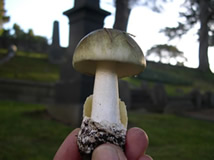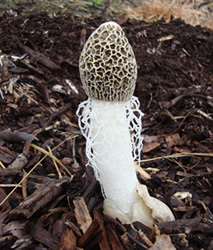
Amatoxin: The Deadliest of All Mushroom Poisonings

Debbie Viess has written a new modern treatment of amatoxin: what mushrooms contain it, mode of action, poisoning symptoms, and best treatments. Although amatoxin causes human and animal deaths around the world every year, with prompt care in a modern medical/veterinary facility, the chances of surviving and having a full recovery are quite good. Only around 12% of healthy adults poisoned will die or require a liver transplant. Without such care, human deaths are closer to 50%.
We lack good statistics for pet poisonings, but their poisonings are often more severe and more often fatal, but even in the case of dog poisonings, there are protocols available that can increase the rate of survival. To read this important new article, follow this link...

Sex and the Single Stinkhorn

Some rumors need a strong denial. In this essay, Debbie Viess obliterates the proposition put forth in a sketchy study published in an obscure journal that a species of stinkhorn may cause spontaneous female arousal. The authors' attempt to wrap this ridiculous idea in Hawaiian myth is firmly debunked. Although first published in 2001, the idea that this phenomenon is real persists and occasionally gets notice on social media sites. To read Debbie's humorous and direct response, follow this link...
This article first appeared in Mushroom the Journal, Issue 114, Volume 31, No.4, Fall 2015, p. 16.
Further Reflections on Amanita muscaria as an Edible Species

Here is a thoughtful response to the current push to eat Amanita muscaria, along with a history of its treatment in field guides, its toxins, and warnings about edibility. To read the article, follow this link...
This article first appeared in Mushroom The Journal, Issue 110, Fall 2011 - Winter 2012, p. 42.

The Bay Area Mycological Society (BAMS), established in 2006, is dedicated to the art and science of mushrooms. We hold meetings at UC Berkeley. We hold local and long distance forays, played key roles in past fungal surveys at Point Reyes National Seashore and Yosemite National Park. We organize the Point Reyes Fungus Fairs and All California Club Forays.
We are affiliated with the North American Mycological Association. We host a lively online discussion group. Our members range from beginners to professionals in the field. We believe that everyone wants to learn, and has ideas to share. Join us.


